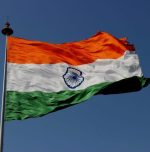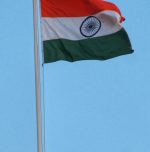Our National symbols

The National Flag is a horizontal tricolour of deep saffron (kesaria) at the top, white in the middle and dark green at the bottom in equal proportion.
The ratio of width of the flag to its length is two to three.
In the centre of the white band is a navy-blue wheel which represents the chakra.
The top saffron colour, indicates the strength and courage of the country.
.
The white middle band indicates peace and truth with Dharma Chakra.
The green shows the fertility, growth and auspiciousness of the land.
The design of the National Flag was adopted by the Constituent Assembly of India on 22 July 1947.
The Indian peacock, Pavo cristatus, the national bird of India, is a colourful, swan-sized bird, with a fan-shaped crest of feathers, a white patch under the eye and a long, slender neck.
The male of the species is more colourful than the female, with a glistening blue breast and neck and a spectacular bronze-green tail of around 200 elongated feathers.
National Anthem
The composition consisting of the words and music of the first stanza of the late poet Rabindra Nath Tagore’s song known as “Jana Gana Mana” is the National Anthem of India. It reads as follows:
Jana-gana-mana-adhinayaka jaya he
Bharata-bhagya-vidhata
Punjaba-Sindhu-Gujarata-Maratha
Dravida-Utkala-Banga
Vindhya-Himachala-Yamuna-Ganga
uchchala-jaladhi-taranga
Tava shubha name jage, tava shubha asisa mage,
gahe tava jaya-gatha.
Jana-gana-mangala-dayaka jaya he
Bharata-bhagya-vidhata.
Jaya he, Jaya he, Jaya he,
jaya jaya jaya, jaya he.
National Song
The song Vande Mataram, composed in Sanskrit by Bankimchandra Chatterji, was a source of inspiration to the people in their struggle for freedom. It has an equal status with Jana-gana-mana. The first political occasion when it was sung was the 1896 session of the Indian National Congress. The following is the text of its first stanza:
Vande Mataram!
Sujalam, suphalam, malayaja shitalam,
Shasyashyamalam, Mataram!
Vande Mataram!
Shubhrajyotsna pulakitayaminim,
Phullakusumita drumadala shobhinim,
Suhasinim sumadhura bhashinim,
Sukhadam varadam, Mataram!
Vande Mataram, Vande Mataram!
The state emblem is an adaptation from the Sarnath Lion Capital of Ashoka. In the state emblem, adopted by the Government of India on 26 January 1950, only three lions are visible, the fourth being hidden from view.
The wheel appears in relief in the centre of the abacus with a bull on right and a horse on left and the outlines of other wheels on extreme right and left.
The words Satyameva Jayate from Mundaka Upanishad, meaning ‘Truth Alone Triumphs’, are inscribed below the abacus in Devanagari script.
The magnificent tiger, Panthera tigris is a striped animal.
It has a thick yellow coat of fur with dark stripes.
The combination of grace, strength, agility and enormous power has earned the tiger its pride of place as the national animal of India.
Lotus (Nelumbo Nucipera Gaertn) is the National Flower of India.
It is a sacred flower and occupies a unique position in the art and mythology of ancient India and has been an auspicious symbol of Indian culture since time immemorial.
The Ganga or Ganges is the longest river of India flowing over 2,510 kms of mountains, valleys and plains.
It originates in the snowfields of the Gangotri Glacier in the Himalayas as the Bhagirathi River.
It is later joined by other rivers such as the Alaknanda, Yamuna, Son, Gumti, Kosi and Ghagra.
The Ganga is revered by Hindus as the most sacred river on earth.
Critically endangered River Dolphin (Platanista gangetica ) is the National Aquatic Animal of India.
The Ministry of Environment and Forests declared the Ganges River Dolphin as the National Aquatic Animal on 18th May 2010.
This mammal is also said to represent the purity of the holy Ganga as it can only survive in pure and fresh water.
.
National Calendar
The national calendar based on the Saka Era, with Chaitra as its first month and a normal year of 365 days was adopted from 22 March 1957 along with the Gregorian calendar for the following official purposes: Gazette of India, News broadcast by All India Radio, Calendars issued by the Government of India and Government communications addressed to the members of the public.
A fleshy fruit, eaten ripe or used green for pickles etc. of the tree Mangifera indica, the mango Mangoes have been cultivated in India from time immemorial.
The poet Kalidasa sang its praises. Alexander savoured its taste, as did the Chinese pilgrim Hieun Tsang.
The symbol of Indian Rupee typifies India’s international identity for money transactions and economic strength.
The Indian Rupee sign is an allegory of Indian ethos. The symbol is an amalgam of Devanagari “Ra” and the Roman Capital “R” with two parallel horizontal stripes running at the top representing the national flag and also the “equal to” sign.
The Indian Rupee sign was adopted by the Government of India on 15th July, 2010.
The symbol, conceptualised and designed by Udaya Kumar, a post graduate in Design from Indian Institute of Technology Bombay.
Indian fig tree, Ficus bengalensis, whose branches root themselves like new trees over a large area. The roots then give rise to more trunks and branches. Because of this characteristic and its longevity, this tree is considered immortal and is an integral part of the myths and legends of India.
Even today, the banyan tree is the focal point of village life and the village council meets under the shade of this tree.
Photo by Srikanth D on Unsplash(Free for Commercial Use)
Image Reference: https://unsplash.com/photos/ReUUh61x1qQ










Leave a Reply